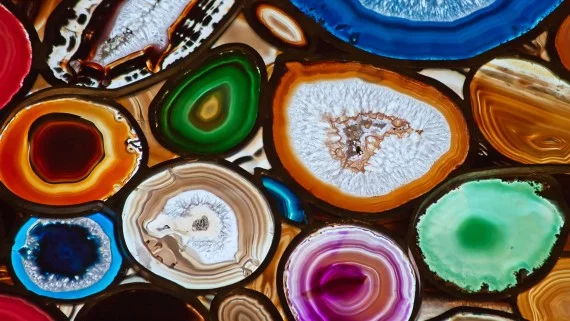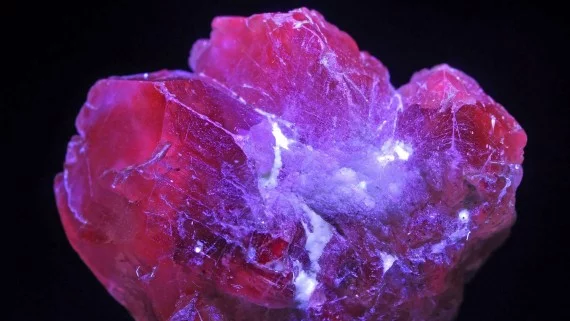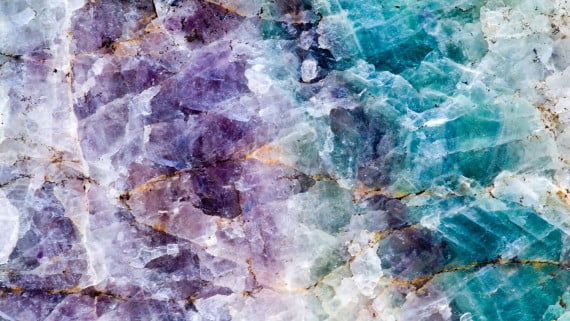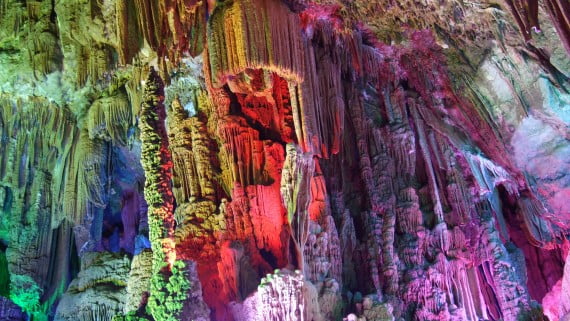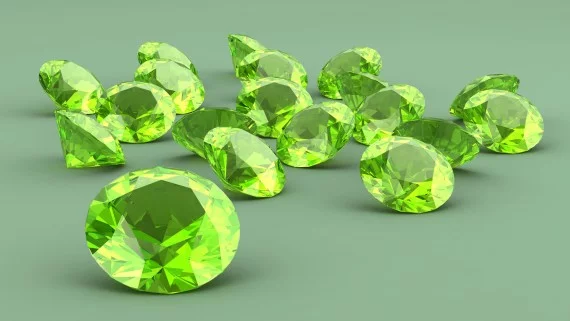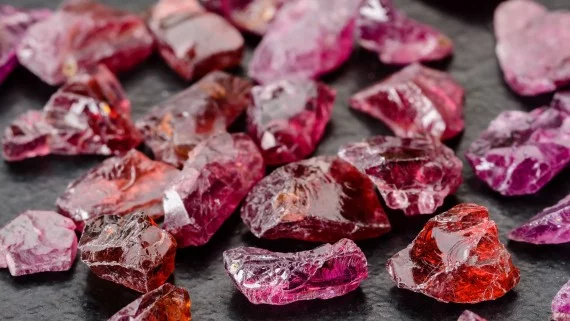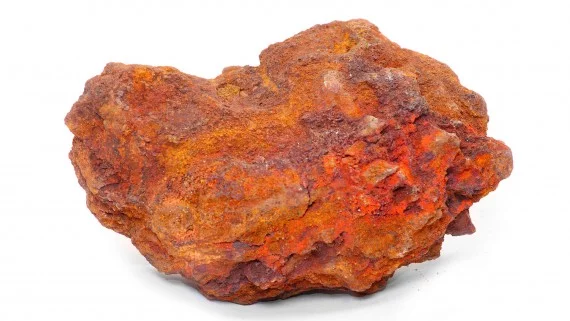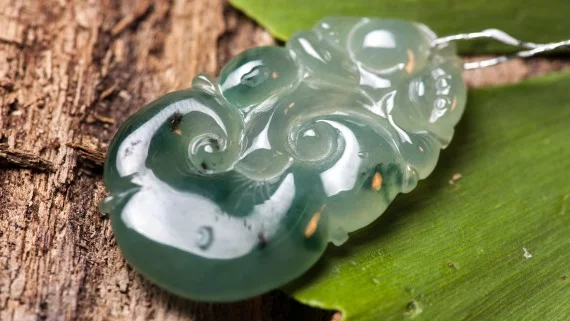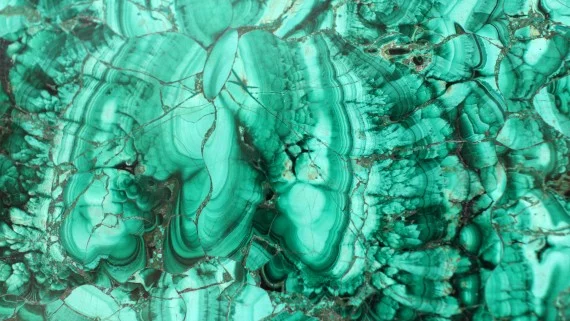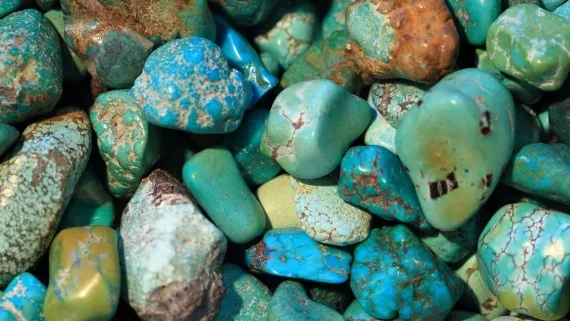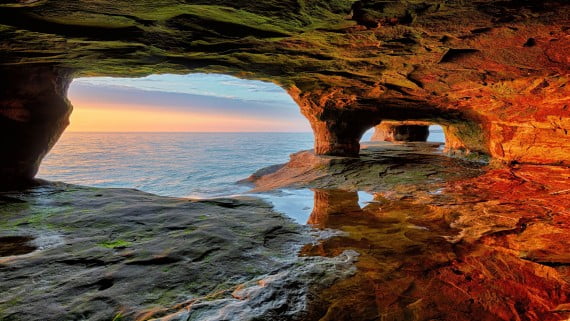On planet Earth, there are endless precious rocks and minerals that an adventurer can find. Traditionally, they have been related to astrology, specifically the signs of the zodiac: Aries with jasper, Leo with yellow topaz, Sagittarius with lapis lazuli ... In this article, we present a list of the most precious rocks and minerals in the world .
Below you have an index with all the points that we are going to deal with in this article.
Article Index
- 1.
- 2.
- 3.
- 4.
- 5.
- 6.
- 7.
- 8.
- 9.
- 10.
- 11.
- 12.
- 13.
- 14.
- 15.
- 16.
- 17.
- 18.
- 19.
- 20.
- 21.
- 22.
- 23.
- 24.
- 25.
Agate
Agate is a microcrystalline variant of quartz, specifically, it is a variety of the mineral chalcedony that presents bands of various colors of the same tone, opaque and translucent.
This mineral is found in volcanic formations de active volcanos and its size can vary from a few millimeters to several meters. The most important deposits of this gemstone are in southern Brazil, the United States, Uruguay, Argentina, India and Madagascar.
Aquamarine
Aquamarine is a highly valued gem in the jewelry industry due to its great hardness, allowing a wide range of cuts. Its greenish-blue color, along with its color and brightness, is largely reminiscent of sea water. In reality, this gemstone is a variant of beryl, as is the case with emerald, which we will talk about later.
The most important mines where it is found are those in Brazil, specifically in Bahia, Espíritu Santo and Minas Gerais, although the most sought-after specimens can be found in the Ural mountains, located in Russia. There are also numerous aquamarine deposits in Italy, Sri Lanka, India and the United States, as well as in several African countries such as Kenya, Madagascar, Nigeria and Tanzania, among others.
Alexandrite
The variant of chrysoberyl known as alexandrite o alexandrite It is one of the most curious stones on the planet due to its most characteristic property: changes its color depending on the angle from which you look at it.
Its weight can vary between 3,5-4 g and it is crystallized in rectangular prisms, whether simple or modified, as well as in rolled crystals, which makes it appear that it changes color due to the vivid reflections produced by said crystallized structures.
To present a greater amount of reflections, it is carved in cabochon, which is a style of gem carving in which the polished stone is left in a rounded shape and with a convex point on a flat base.
This precious stone is found in ganitic lands such as those of Minas Gerais (Brazil), the Ural Mountains (Russia), the island of Ceylon and the United States.
Amethyst
Amethysts are found in the interior of geodes, that is, the cavity of a rock in whose walls are embedded minerals of greater or lesser crystallization and projected inwards.
This rock is a macrocrystalline variety of violet colored quartz whose intensity varies according to the amount of iron it contains. In addition, some areas show yellow reflections and the tips may be darker or gradually degrade until they are colorless.
Amethyst is a very susceptible to heat, so when it is heated above 300 ° C, it changes its color to orange, green, yellow or brown, depending on the temperature.
The main amethyst deposits are located in Germany, the Ural Mountains (Russia), Zambia, Brazil, the Artigas Department (Brazil), Canada, India, Sri Lanka and Tunisia, among others.
Amber
The gemstone known as amber, Arabic o succinct It is a rock from the fossilized plant resin of conifers and angiosperms. Has the ability to float on the water, hence its name, which derives from Arabic and literally means what floats in the sea.
The original source of amber is the region of Baltic Sea. The oldest piece worked by the human being dates from about 30.000 years ago and was found in Hannover (Germany). To this day, it can be found in the Solutrense of the Altamira cave (Santillana del Mar, Cantabria, Spain), as well as in France, Lithuania, Poland, Latvia, Mexico, the Dominican Republic, Nicaragua and Colombia.
Quartz
Quartz is a silica-based mineral. Is he most common mineral of the earth's crust, mainly because it can be found in a large number of metamorphic, sedimentary and igneous rocks.
In addition, it is highly valued by the esotericism given its value as an amulet or talisman for certain zodiac signs such as Aries, Virgo or Capricorn.
Amethyst or citrine, among others, are some of the many varieties of quartz collected by gemology. There is a highly valued variety known as rock crystal characterized by being totally transparent and without color defects. This variant can be found in Minas Gerais (Brazil).
Other quartz variants are: white or milky quartz, smoky quartz, pink quartz, blue quartz, green quartz, agate, jasper, brown quartz, chalcedony, chrysoprase ...
Diamond
Diamond is one of the most valued minerals in the world for its physical and optical characteristics, all of them remarkable. It has an extremely rigid crystal structure, which, combined with its high transparency, results in the clear, colorless appearance of most natural diamonds.
Since it is visually very similar to diamond, the synthetic cubic zirconia It has been the main gemological competitor of diamond since 1976, due to its low cost and durability. It is a hard synthesized material, free from optical faults and usually colorless, with few exceptions. It should not be confused with zircon, which is discussed later.
The main diamond deposits are in India, Namibia, Brazil, Sierra Leone, Colombia, Venezuela, Peru, Mexico, the United States, Ghana and South Africa.
Emerald
Emerald is another variety of beryl, a mineral that contains chromium and vanadium. Specifically, the emerald is green and its hardness, according to the Mohs scale, varies between 7,5-8, with a weight of between 2,65-2,90 g.
Given its rarity, it is one of the most valued minerals on the planet. Its name, of Persian origin, means green stone and its color has given its name to a variant of the color green known, in effect, as emerald green.
There is a deposit in the Boyacá Department (Colombia), more specifically in the municipalities of Muzo, Chivor, Otanche and Coscuez. Also in Brazil, the eastern desert of Egypt and Zambia can be found, although to a lesser extent.
Fluorite
Fluorite is a mineral formed by the combination of calcium and fluorine, which is why it is also known as fluorspar o fluorine. Its habit or macroscopic appearance is cubic, octahedral or dodecahedral rhomboid and it possesses the physical property of fluorescence to ultraviolet rays.
Its color, which ranges from transparent to opaque, depends on the state of purity of the specimen in question. On multiple occasions, crystalline pieces have green or bluish reflections, especially when illuminated with fluorescent or black light.
The main world deposits of fluorite are in Spain, England, China, the USA and Mexico, of which the latter exports between 60 and 75% of its total production. In Spain, a country of great importance in the production of this mineral, it is found mainly in Asturias, specifically in the terms of Ribadesella and Caravia.
Garnet
Garnet is a mineral of the same color as its name indicates, although it can also be found in shades of orange, yellow or even black. It belongs to the family of aluminum silicates combined with iron and magnesium oxide, which makes it have this characteristic reddish-garnet color.
There is a variant of this mineral called green grossular garnet, better known by its trade name: Tsavorite. It is one of the three varieties of garnet characterized by its intense green color. Its designation as Tsavorita dates back to 1974.
This mineral is curiously mentioned in the Biblia under the name carbunculus. Its name derives from the Latin granatum, a term that did not refer to color, but simply meant germ.
It can be found in large proportions in nature and, due to its appearance similar to that of Ruby, It is usually used in jewelry as a substitute for this to lower costs. One of the most important deposits is Putian, Putian Prefecture, Fujian Province, China.
Hematite
Hematite, also known as oligist, is a mineral composed of ferric oxide that constitutes a very important source of iron, since in its pure state it can contain up to 70% of this metal.
Its color, due to its high iron content, varies from metallic to sub-metallic, depending on the brightness, and it looks like small mirrors. However, there is a variant called earthy hematite that draws attention for its reddish tones that stain the skin when touched.
The variety of earthy hematite can be found in the cave of Altamira (Spain) and on the island of Elba (Italy), although without a doubt the most striking place is the planet Mars, where NASA found remains of this rock in two places: Medidiani Earth and Aram Chaos.
Jade
The ornamental rock known as jade Since ancient times, it has been a material used for the manufacture of utensils and ornaments, which is why over time a true cult of this rock has developed. This, in turn, has led to objects made from jade being regarded as good luck charms.
During the time of the prehispanic cultures of Mesoamerica, indigenous communities like the Mayans, the Toltecs, the Aztecs or the Olmecs, among others, they used it as a symbol of life, fertility and power, and it was even more valued than gold itself.
In ancient times it was found in the Motagua valley, Guatemala, specifically in the area of the Motagua fault. Currently, it can be found in the Motagua river valley (Guatemala), where one of the richest deposits in the world is located, since there you can find different types of jade, such as rainbow jade and black jade with natural inlays of gold, platinum and silver.
Kunzite
Kunzite, cuncite or spodumene is a mineral whose name comes from the Greek term spods, Meaning ash. It is usually found in deposits where lepidolites, quartz, beryl and tourmaline are also found. In addition, there are two varieties of Kunzite: on the one hand, the kunzite pink and, on the other, the green kunziteKnown as hidenite.
This mineral is one of the most valued within esotericism, an area in which it symbolizes the externalization of joy and serenity in the form of emotions and thoughts.
It has a high economic importance since it can be used as lithium source and, sometimes, it is also used as a fine stone. This mineral is difficult to find; however, the most common are those of Peterhead (Scotland), Killiney (Ireland), Madagascar, Bikita (Zimbabwe), Brazil and various parts of the USA.
Labradorite
Labradorite, also known as spectrolyte It is a mineral composed of sodium and calcium. Its name is due to the fact that the first specimen found of this mineral was found in the labrador peninsula (Canada). In Spanish it is known by other names such as silicite, rhadowite, mauilite y carnatite.
Its other name, spectrolite, is due to spectral iridescence, known as labradorscence, which characterizes this mineral. This property means that in each specimen a range of colors can be observed, ranging from blue to violet, through yellow or orange, among other shades.
Today there are still notable deposits on the Labrador Peninsula (Canada) and the Scandinavian Peninsula. Its use is mainly the manufacture of ceramics, refractory materials and enamels, although it is also usually used in jewelry for the manufacture of necklaces.
Lapis lazuli
Lapis lazuli is a gem that draws attention for its characteristic blue color and is one of the semi-precious stones most appreciated by the jewelry sector since ancient times.
In the Middle Ages, lapis lazuli was used for the blue pigment it provides, colored ultramarine blue, in art or in the textile sector to dye fabrics. During Renaissance Europe, it was in high demand by great painters such as Leonardo da Vinci or Albrecht Dürer, among others.
There are several deposits around the world where this stone can be found. One of them is found in the western Hindukush mountains in Afghanistan, as well as in Germany, Angola, Chile, the United States, Pakistan, Lake Baikal (Russia) and the Chilean Flor de los Andes deposit.
Malachite
Malachite is a mineral composed of almost a 60% copper. Like lapis lazuli, it was formerly used as a colorant; today, however, its use is limited to jewelry.
Malachite has also been used in Fine Arts, as can be seen in the St. Isaac's Cathedral, in Saint Petersburg (Russia), whose columns are covered with malachite plates, hence its green color.
Currently, malachite can be found in various deposits in Colombia, Congo (Zaire), northern South Africa, Zimbabwe, Namibia, Hungary, the USA and Russia.
Eye of trigre
The tiger's eye is the result of a mixture of several minerals, all of them from brown colors and yellowish. Its main base is quartz, but it also contains some limonite and riebeckite.
This semi-precious stone has other variants, considered as its "sister cousins": the cat's eye and the hawk's eye. All of them are used mainly in jewelry and as a component in artistic works.
There are several beliefs about the tiger's eye, including that a necklace or bracelet made from this material protects against the evil eye, witchcraft, spirits and diseases, among others, especially in world religions such as the Buddhism, Islam, Hinduism.
The main deposit in the world is in South Africa, specifically in the city of Kimberley. Also in Australia Western, Burma, India, Brazil and the United States can be found this mineral.
Pyrite
Pyrite is a mineral composed of sulfur (53,48%) and iron (46,52%) and has a solid texture. Its name comes from the Greek term pyr, Meaning fire, because when it rubs against other materials emits sparks.
Due to its great resemblance to gold, it is popularly given other names such as fool's gold, the gold of the poor u tinsel.
Due to its high sulfur content, pyrite is used extensively for the production of sulfuric acid by roasting pyrite.
Some of the most important reserves of pyrite are located in Spain, specifically in the Tinto River (Huelva), whose deposits have been exploited for more than 30 centuries. Other Spanish towns are: Cartagena (Murcia), Santander and La Rioja.
Rubí
Ruby is one of the most demanded diamonds in the jewelry sector, mainly due to the beauty of its reddish-pink color resulting from a mix between iron and chromium. In fact, its name derives from the term ruber, Meaning Red In latin.
Ruby can be found in a large number of deposits worldwide. Thus, those of Burma, Sri Lanka, Madagascar, Thailand, Brazil, Colombia, Russia, China, South Africa, Australia, Greenland, the Malay Peninsula and Tanzania, among others.
Topaz
Topaz is a mineral frequently used as a gemstone with a hardness of 8 on the Mohs scale. However, it fractures very easily, making it difficult to work.
De magmatic origin, it is found embedded in pegmatites and granites, as well as in rhyolite cavities and quartz veins. Its crystals are usually large, with dimensions of approximately 80 x 60 x 60 cm.
The main topaz deposits are located in the Czech Republic, Brazil, Saxony, Norway, Sweden, Japan, Mexico, Sri Lanka, Burma, Pakistan and the United States.
Turquoise
The characteristic that most attracts the attention of gemmology amateurs around the world is its greenish blue color, known as turquoise because of this mineral. It is a rare mineral, which gives it a high value.
For thousands of years, it has been prized as a precious and ornamental stone primarily for its unmatched color. It is also a mineral very fragile, even in its finest versions.
As mentioned above, it is a rare mineral and of secondary formation. For this reason, it is usually found in desert regions. The majority of turquoise extractions are carried out by hand, either with little mechanization or directly without any aid tool.
In the United States, it can be found as a by-product of copper mining, although the main deposits are in Spain, more specifically in Valdeflorez, El Trasquillón and Logrosán (Cáceres), as well as in Cardeña (Córdoba) and Mazarrón (Murcia).
Tourmaline
Tourmaline is a mineral that has acquired various names by mineralogists over time, such as elaborates, dravite, tsilasite, uvita, rubellite, etc.
This gemstone already caught the attention of the philosopher Theophrastus 2.300 years ago, who called it lingurion and considered that it had the property of attracting straw, ash or chips, among others, when heated, which revealed its pyroelectric properties.
One of the biggest fans of tourmaline was the Chinese Empress Cixi or Tzishí, who ruled from 1860 to 1908. His passion for this mineral was such that he now rests on a cushion made from tourmaline.
The color of tourmaline is very variable, so it can be found in black or rather pink, in the latter case considered as a love charm. Black are abundant west of the Iberian Peninsula. There is a green variant that can be found in Brumado, Bahia (Brazil). Other deposits are those of New York and Lastovietky (Czech Republic).
unakite
Unakite is a type of altered granite that is made up of green epidote, colorless quartz, and pink orthoclase. Its main deposit is located in the Unaka Range (North Carolina, USA), from which it takes its name.
When its quality is very high, it can be considered a precious stone. Its most common use is for the production of jewelry items, such as cabochons, beads and lapidary pieces in the shape of a sphere, egg, etc.
It can be found in glacial stacking boulders and pebbles on the shores of the Lake superior, which constitutes one of the Great Lakes of North America. In addition, it can also be found in Sierra Leone, Brazil, China and South Africa.
zafiro
Sapphire is one of the most important gems on the planet and one of those that top the list of the most beautiful along with diamond, emerald and ruby. Also know as ultralight, It is usually found in deposits rich in hematite, bauxite and rutile.
Its blue color is due to the fact that its composition includes aluminum, titanium y iron. However, it can be found in a multitude of shades ranging from red to yellow.
The main sapphire deposits are in Africa and South America, the latter recently found. In Siam and Sri Lanka it can also be found associated with rubies, as well as in Kashmir (India) and in Central Queensland (Australia).
Zircon
Zircon, also written zircon, is a mineral of variable color, so there are different variants of it, such as hyacinth, a type of yellowish zircon that can be found in India.
The main characteristic of zircon is that it is the oldest mineral known on Earth and one of the most abundant in the earth's crust. Its formation took place from the crystallization of magmatic rock such as granite or some alkaline rocks such as syenite.
Zircons are often used for jewelry production. Its main deposit is in Cambodia, near the border with Vietnam, although there are also other producers distributed between Sri Lanka, Thailand, Australia, the United States, South Africa and France, among others.
This article has been shared 470 times. We have spent many hours collecting this information. If you liked it, share it, please:

